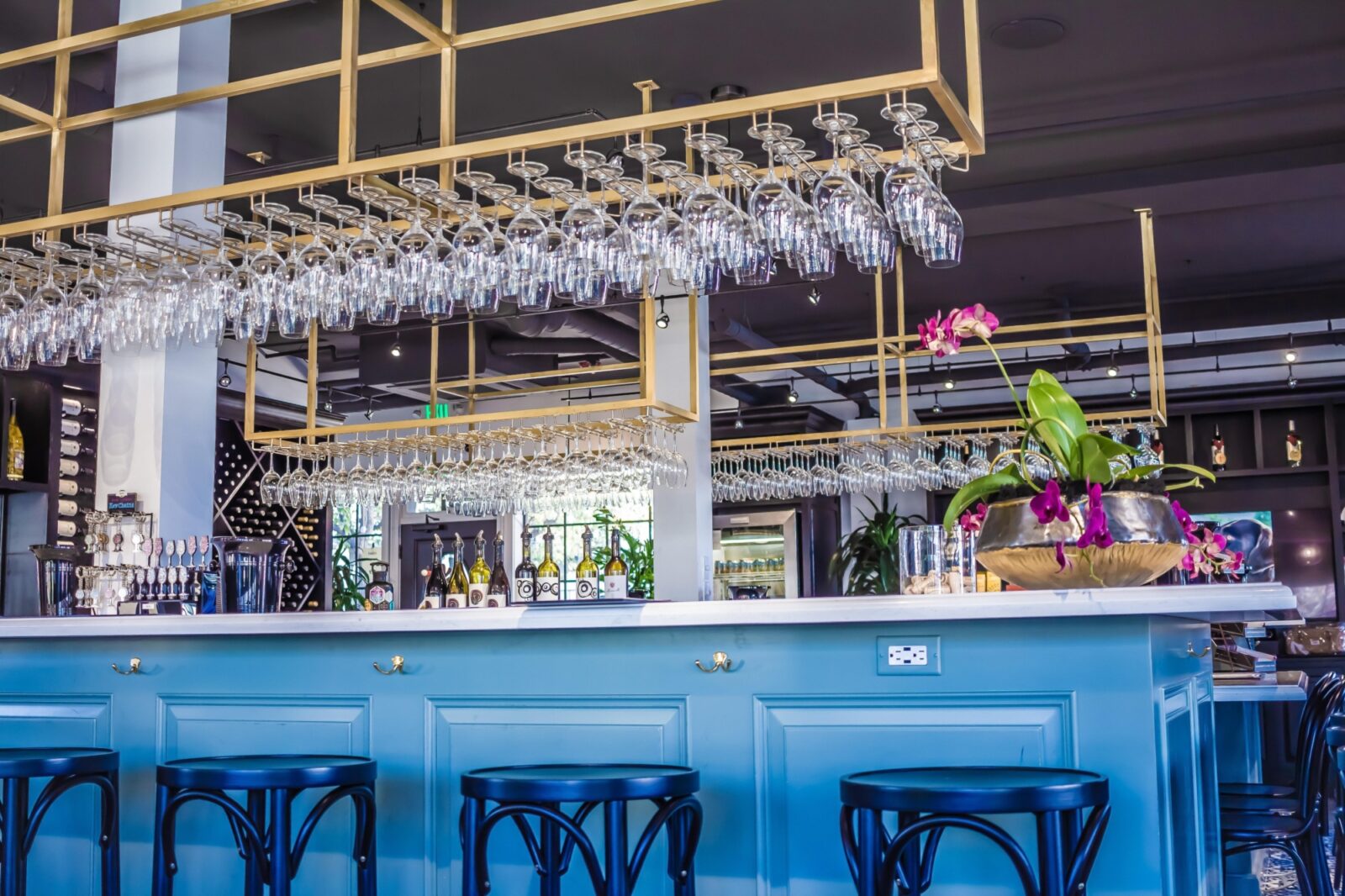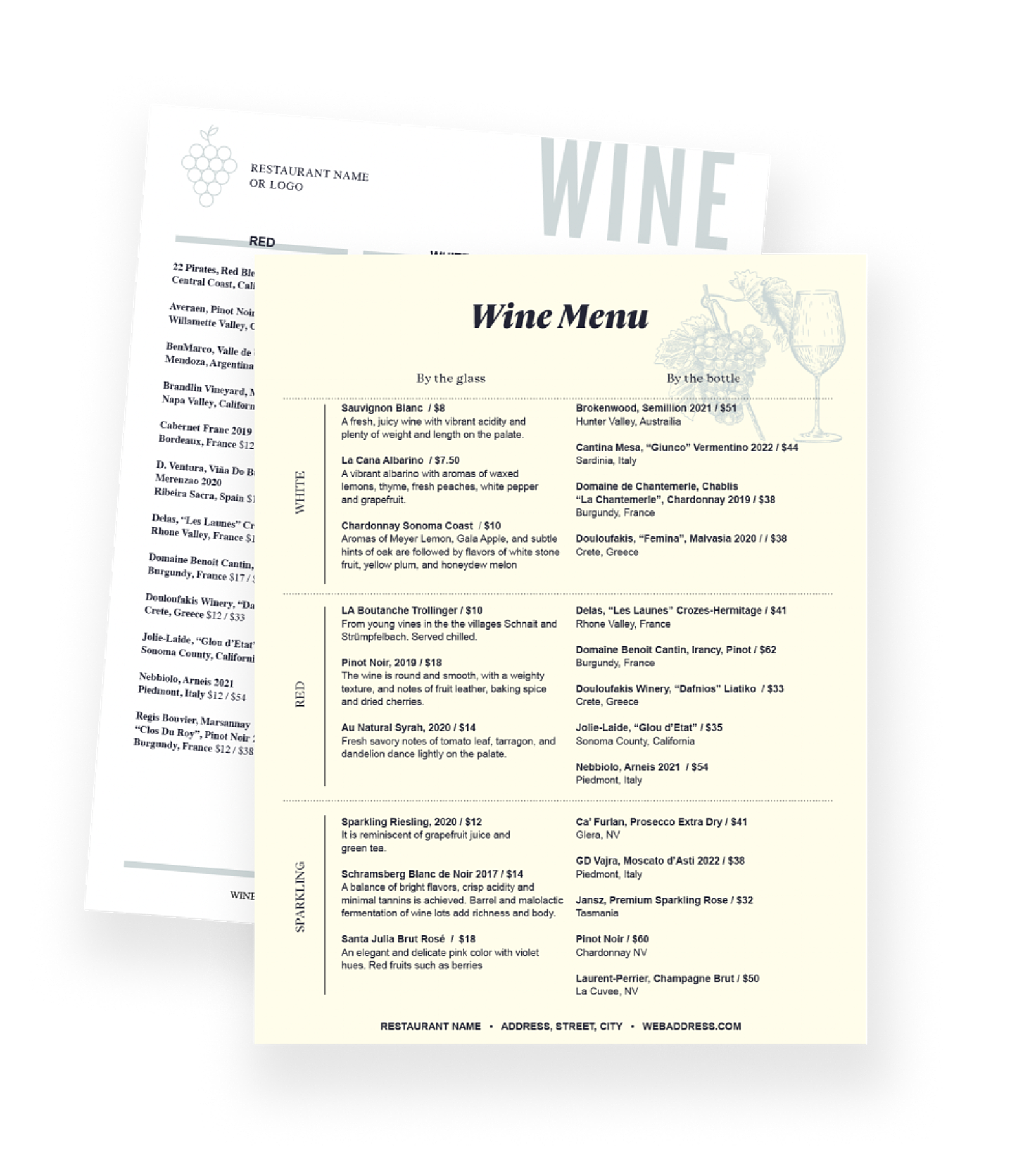
What is a Wine Bar?
What makes a wine bar different? We’ve got the answers.

Nick PerryAuthor


Wine Menu Templates
Use these wine menu templates as a starting point for your menu design or to give your menu a refresh.
Get free downloadOnce upon a time, you might have been able to reasonably refer to a bar that sold wine as a wine bar. These days, however, “wine bar” has a designation all its own.
Wine bars have taken on a life of their own in cities all over the country and the world. While it can be a nebulous term, a wine bar is essentially a sit-down food and drink establishment that offers an extensive wine list offered by the bottle and glass. Most offer at least some kind of appetizer or small plate menu rather than a complete entree menu. While wine bars come in many styles and ambiances, a true wine bar focuses on wine and lounging first, with everything else being secondary.
The wine bar experience is often about sampling wines from around the world and enjoying the bar’s collection, which is likely more exclusive and rare than the typical bar or restaurant. Unlike other bars that may be a bit rowdier, wine bars tend to be classier and more sophisticated.
In this article, you will learn about the history of wine bars and the elements that make them one of the fastest-growing restaurant types in America today.
Wine Menu Templates
Use these wine menu templates as a starting point for your menu design or to give your menu a refresh.

The Role of Wine Bars in the Hospitality Industry
While the wine bar concept is a fairly American one, it draws inspiration from more traditional and common establishments in wine-loving countries around the world. For instance, bars à vin in France, enoteche in Italy, and bars de tapas in Spain have been around for centuries. These establishments are such an integral part of the cultural fabric of these countries, however, that they transcend the niche term wine bar.
The wine bar trend began in earnest in the United States in the 1980s in winery cities like San Francisco and Napa, as well as upscale areas in New York. While the concept didn’t gain steam until the 1990s, these early wine bars sought to tone down the high-end ostentatiousness of wine culture in the ‘80s. The cozy, plush bars offered outstanding wine at more affordable prices in a casual atmosphere.
By the early 2000s, the democratization of wine was well underway, making wine bars increasingly popular, especially with middle-class professionals. Today, they’re akin to coffee shops and local bars as third spaces where people can gather with friends.
In recent years, wine bars have frequently begun to incorporate food into the experience. Many wine bars celebrate the wines of specific countries, and will therefore also offer small plates, charcuterie, or desserts that reflect the traditions of those countries. It’s all about dressing down the upscale fine dining experience without dressing it all the way down.
Elements of a Wine Bar
So, what really makes a wine bar different from other food and drink establishments? Let’s cover a few of the key elements here.
Wine selection and variety
Naturally, a foundational element of any wine bar is its menu. As we’ve mentioned, many wine bars focus on a particular country’s wine, be it a classic nation like France or Italy, or a less celebrated producer like Greece or Argentina.
However, that’s not always the case. Some wine bars may prefer to feature the owner’s personal collection or tastes, or make local wine the focus, or just act as intermediaries to source great wine from around the world to create a balanced, delicious menu. Most importantly, a wine bar offers a variety of wines that appeal to all tastes.
Wine bar ambiance and design
To reiterate the point, the subdued, yet effortlessly classy ambiance and design is a classic element to a wine bar. You must consider the clientele. Who would want to spend their nights out sipping wine and munching on charcuterie rather than at a more raucous bar or club.
Yes, wine bars tend to have an artist’s aesthetic. The ambiance promotes relaxation and may include some tasteful live music, artistic elements in the design or decor, and is typically on the darker side. Wine bars want patrons to sit and stay awhile, so they’re closer to lounges than the typical beer bar.
Food offerings and pairing recommendations
As wine bars tend to cater to connoisseurs, expect to have a sommelier on-site to help patrons navigate the menu and find the right wines to their tastes. If the bar serves food, wait staff (or the menu) should also be able to offer pairing recommendations for items on the menu.
A great wine bar should at least offer an educational experience for those who are interested in learning more about wine. Sommeliers can help customers make observations about the appearance of the wine, instruct them to give it a swirl and a sniff, and taste a small sip with a swirl to oxygenate the wine before swallowing. The wine-tasting experience can help patrons identify where a wine comes from, the grapes used to make it, what kind of fruits or floral notes it has, or even how the wine was made.
Outstanding sommeliers can not only showcase their knowledge of wine, but they can guide customers on the basics of wine tasting and etiquette to provide a window into the high-end world of wine.
Types of Wine Bars
As we mentioned in the intro, the term wine bar can be a bit nebulous. It’s an umbrella term that encapsulates many different types of bars. Let’s go into some more detail here.
Dedicated wine bars
The purest form of the wine bar, these establishments are all about the wine. They’re in competition with high-end restaurants to hire the best sommeliers and, because they only serve wine (and maybe some crackers or cheese), they likely source larger and better collections than you’ll find elsewhere.
You’ll know a dedicated wine bar if the menu leads with wine and the service is centered around a wine experience.
Wine-focused restaurants with a bar area
Many restaurants put an emphasis on wine and creating a complete dining experience around food and wine pairings. But when the focus is at least split between food and wine, it’s really more of a restaurant than a wine bar.
That said, sometimes restaurants that value the wine-tasting experience will offer a bar area within the restaurant that has a greater dedication to wine.
These are some of the most expensive types of wine bars to open given the costs associated with running a luxury kitchen.
Wine bars within wineries or vineyards
Tasting the wine is a core part of the experience when you’re visiting a winery or vineyard. Most achieve this by offering a bar where you can order a glass, buy a bottle, or arrange a tasting of the brand’s wines. These are surely wine bars, but they’re a little different given that they only offer the wines they make onsite.
Notable Wine Bars Around the World
Wine bars are globally popular and are becoming even more so as wine culture grows. Some of the most famous include:
Vinosofia, Spello, Italy: Considered one of the world’s best wine bars, Vinosofia combines a rich selection of locally sourced wines (with a new region of Italy featured each month) with extraordinarily picturesque design and decor that highlights the region’s history. Not only that, Vinosofia is known for charcuterie starring local cheeses, salami, and olives.
Osteria Bancogiro, Venice, Italy: It’s next to impossible to recreate the ambiance of Osteria Bancogiro, located at the foot of the Rialto Bridge next to Venice’s Grand Canal. The experience is only amplified by a sommelier-curated menu of many Italian varietals, plus crostini. Whether you’re just looking for a sip or you’re waiting for a table at the restaurant upstairs, Osteria Bancogiro offers an extraordinary Italian dining experience split across bar and restaurant.
Swirl Wine Bar, Toronto, Canada: Swirl is an excellent example of how creative people can get with wine bars. This converted apartment above a dog store is filled with art from local artists and antique decor that makes it feel part wine bar, part living space, part museum. Swirl goes a bit beyond the call of typical wine bars by offering some beer and cocktails, as well, but it’s the vibe that really makes it a wine bar. Board game nights, cinema Sundays, and community nights make it something special.
Cadet Wine, Napa, California: The US’s most famous wine region, Napa is full of wine bars and tasting rooms, but Cadet is one of the finest. The classic bar highlights Northern California and imported wine and beer producers with a particular emphasis on building community. The food menu frequently changes with locally sourced seasonal ingredients and they offer a Guest Bartender Night every week to feature different producers.
***
The term wine bar can mean a lot of things these days. That’s due in large part to the bar type’s increasing popularity. As wine culture grows and democratizes, it’s easier than ever for anybody to appreciate and learn about fine wine. Wine bars help to promote wine culture while providing stylish, cool places for communities to gather.
Is this article helpful?
DISCLAIMER: This information is provided for general informational purposes only, and publication does not constitute an endorsement. Toast does not warrant the accuracy or completeness of any information, text, graphics, links, or other items contained within this content. Toast does not guarantee you will achieve any specific results if you follow any advice herein. It may be advisable for you to consult with a professional such as a lawyer, accountant, or business advisor for advice specific to your situation.
Read More
Subscribe to On the Line
Sign up to get industry intel, advice, tools, and honest takes from real people tackling their restaurants’ greatest challenges.



